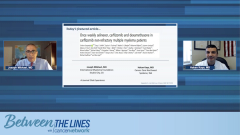
Clinical Implications: Selinexor, Carfilzomib, and Dexamethasone in R/R MM
Dr Mikhael and Dr Kaya discuss the clinical implications and share their thoughts on the use of selinexor, carfilzomib and dexamethasone in patients with R/R MM.
Episodes in this series

Joseph Mikhael, MD: We now through the NCCN guidelines in patients with early relapsed myeloma have two potential combinations with selinexor, with bortezomib based on the phase three Boston study and now with carfilzomib based on the study that we're discussing today. Let me turn to my friend and ask you, Dr. Kaya, what is your sort of immediate reaction to looking at these results? Is this what you've seen and expected in your clinical practice? Is this surprising to you now? What does your first pass take on this?
Hakan Kaya, MD: Thank you, Joe. Overall response rate of 78%, including 44% VGPR or better is really significant in clinical practice, especially concerning that these patients were heavily treated, many of them were triple refractory, and many of them, more than 65% of them were refractory to Dara. As you know from the studies and from our experience is that patients with multi-myeloma who are refractory to Dara don't do well. It was amazing to me that they had such a good response and duration of response was significant as well. As you said, it's a little short of almost two years so it is nice to be able to tell a patient that, hey, with this regimen you may be able to get close to two years. It is really important this day and age with multi myeloma. As you know, we have so many new therapies in the horizon so if we can get our patient to keep going with the current regimens, they will be eligible for the upcoming regimen, so it is really, really important. So 22 plus months of duration response is very significant or 15 months of PFS is really significant as a clinician in my mind.
Joseph Mikhael, MD: I agree with you. I think the other aspect to that is it is really following this kind of philosophy that we have been embracing in myeloma, which is that we don't save the best for last, as it were, that we want to earlier in the disease course expose patients to different mechanisms of action. As we're now often using carfilzomib in the earlier relapse setting, this is sort of a natural partner. I'm sure like yourself, I've had the opportunity to partner selinexor with literally every myeloma agent, daratumumab, bortezomib, lenalidomide, pomalidomide, cyclophosphamide. We've tried it with just about everything. To me, this is almost the natural partner for several reasons. One, the efficacy as you've mentioned, but also, I was struck in the study that over half of patients had high-risk disease. I don't exclusively use it in my high-risk disease patients, meaning I can use it in standard risk, but I have been very much drawn to this, especially when patients may have a P53 deletion or have another feature of high risk that I know is going to be more difficult to manage. Is that what you've seen as well? Do you tend to default towards using the XKD regimen in that context?
Hakan Kaya, MD: I think you made a really good point, Joe, because as you know, at the diagnosis, only 15% to 20% of the patients will have high risk cytogenic but with time when they develop relapsed refractory, this is about 50%. In this study, it was more than 50% of patients having 17p deletion, 414 translocation, 1416 translocation of chromosome one abnormality. These patients, as you know, are really difficult to treat because they don't respond well, and the response doesn't last very long. I was actually very impressed with this study showing that they had such good response and durable responses but as you said, when I have a patient, it doesn't matter if they have high-risk disease or not. If I'm going to have to treat them with this regimen, I still go ahead and treat them, but I think I will feel better treating a high-risk patient knowing that results were good. Otherwise, even if they don't have 17p deletion, I'm still going to give them this very useful regimen.
Joseph Mikhael, MD: I agree with you. I found that to be very comforting. The other feature to this that I think is interesting is that almost like in the Boston study where selinexor was partnered with bortezomib on a once-weekly regimen, where both the bortezomib and the selinexor were given once weekly, it's reassuring to see a study using the carfilzomib once weekly. I don't know if you do that typically in your practice, but I've almost exclusively shifted my carfilzomib patients from twice a week to once weekly. I found it to be just as effective and indeed considerably more convenient for the patient to be able to do it. It sort of fits with the modalities. I've often said that every single drug in myeloma goes through an evolution. We learn it, we learn how to make it more effective and in fact more safe. I think we've learned this with bortezomib going from twice weekly to once weekly and carfilzomib from twice weekly to once weekly, from Daratumumab from IV to sub-q. I think we're seeing that same thing here with selinexor that although very effective in that twice-weekly strategy, it was tough and we're going to come to tolerating the drug in a moment but now that we use it once weekly, we have that opportunity to partner it with others.
Newsletter
Stay up to date on recent advances in the multidisciplinary approach to cancer.



















































































